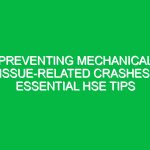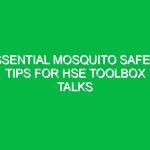Introduction
Risk assessment for cleaning of local exhaust ventilation (LEV) fans is a critical component within the Health, Safety, and Environment (HSE) domain. It plays a pivotal role in ensuring that workplaces are safe and compliant with legal Standards while protecting the health of employees and the surrounding environment. LEV systems are essential in various industries, including manufacturing and construction, as they mitigate airborne contaminants by removing harmful dust, fumes, and vapors. However, the effectiveness of these systems hinges on proper Maintenance, particularly the cleaning of LEV fans.
This article delves into the nuances of risk assessment related to cleaning LEV fans, discussing its significance, methodologies, potential Hazards, and Best Practices. By understanding the importance of thorough risk assessments, organizations can foster a culture of Safety and compliance, ultimately leading to a healthier work environment.
Understanding Risk Assessment for Cleaning LEV Fans
Risk assessment is a systematic process that involves identifying, evaluating, and prioritizing risks associated with a specific activity or Operation. In the context of cleaning LEV fans, this involves assessing potential Hazards, determining the likelihood and impact of those hazards, and implementing Control Measures to mitigate risks. The process can be broken down into several key components:
1. Hazard Identification
The first step in risk assessment is identifying hazards associated with cleaning LEV fans. Common hazards may include:
- Electrical Hazards: LEV fans are typically powered by electricity, which poses risks related to electric shock or equipment failure.
- Mechanical hazards: Moving parts of the fan can cause injuries if workers are not aware of their operation.
- Exposure to contaminants: Workers may be exposed to harmful dust or chemicals when cleaning fans, especially if proper Personal Protective Equipment (PPE) is not used.
- Slips, trips, and falls: Cleaning activities often involve working at heights or on slippery surfaces, increasing the risk of accidents.
2. Risk Evaluation
Once hazards are identified, the next step is to evaluate the risks associated with those hazards. This evaluation typically involves considering the likelihood of an incident occurring and the potential severity of its consequences. A common approach is to use a risk matrix, which categorizes risks into levels such as low, medium, high, or critical.
3. Implementing Control Measures
After evaluating risks, organizations must implement appropriate control measures to mitigate them. Control measures may include:
- Engineering controls: Installing guards or barriers to prevent access to moving parts.
- Administrative controls: Establishing safe work Procedures, including lockout/tagout protocols during cleaning.
- Personal protective equipment: Providing gloves, goggles, masks, and other protective gear to workers.
4. Monitoring and Review
Risk assessment is not a one-time activity; it requires ongoing monitoring and review. Regular inspections of LEV systems and cleaning protocols help ensure that control measures remain effective and that any new hazards are addressed promptly.
Benefits of Conducting Risk Assessments
Conducting risk assessments for cleaning LEV fans yields numerous Benefits that extend beyond mere compliance with Regulations. These benefits include:
- Enhanced Safety: A thorough risk assessment identifies potential hazards, allowing organizations to implement measures that protect workers from accidents and injuries.
- Regulatory compliance: Many jurisdictions have legal requirements regarding Workplace Safety. Conducting risk assessments ensures compliance with these regulations, reducing the likelihood of fines or legal issues.
- Increased efficiency: By identifying and mitigating risks, organizations can streamline cleaning processes, minimizing downtime and improving productivity.
- Improved employee morale: A commitment to safety fosters a positive workplace culture, leading to higher employee satisfaction and retention.
Potential Hazards and Safety Considerations
In the context of cleaning LEV fans, several potential hazards warrant specific attention:
1. Electrical Safety
As mentioned earlier, LEV fans operate on electricity, making electrical safety paramount. Workers should always disconnect power sources before cleaning and use insulated tools to prevent electric shocks. Regular inspections of electrical equipment can help identify potential hazards before they lead to incidents.
2. Working at Heights
Cleaning LEV fans often requires access to elevated surfaces. Proper Training in working at heights is essential, as is the use of Fall Protection systems, such as harnesses and guardrails.
3. Exposure to Contaminants
Cleaning activities can disturb dust and other airborne particles. Using appropriate respirators and ensuring adequate ventilation can significantly reduce the risk of respiratory issues among workers.
4. Manual Handling
Cleaning often involves lifting or moving heavy equipment. Training workers in proper lifting techniques and using mechanical aids, such as hoists or trolleys, can minimize the risk of musculoskeletal injuries.
Best Practices for Risk Assessment
To maximize the effectiveness of risk assessments for cleaning LEV fans, organizations should adopt Best Practices, including:
1. Involve Employees
Engaging employees in the risk assessment process not only fosters a culture of safety but also provides valuable insights into potential hazards that management may overlook. Workers who perform cleaning tasks daily often have firsthand knowledge of risks and can contribute to identifying and mitigating them.
2. Regular Training
Conducting regular training sessions on safety protocols, equipment handling, and emergency procedures ensures that employees remain aware of potential hazards and the importance of following Safety Measures.
3. Documentation
Thorough documentation of risk assessments, control measures, and training records is crucial for compliance and continuous improvement. This documentation serves as a reference for future assessments and can be invaluable during audits.
4. Use Technology
Incorporating technology into risk assessments can streamline the process. Software solutions can help organizations track risks, manage compliance, and facilitate communication among team members.
Regulations and Standards
Various regulations and standards govern risk assessment for cleaning LEV fans, emphasizing the importance of maintaining safety in the workplace. Some key regulations include:
1. The Health and Safety at Work Act 1974 (UK)
This legislation outlines the general duties of employers to ensure the health, safety, and welfare of employees. Conducting risk assessments is a fundamental requirement under this law.
2. The Control of Substances Hazardous to Health (COSHH) Regulations (UK)
These regulations require employers to assess and control the risks associated with hazardous substances, including those that may be present during cleaning activities.
3. The Occupational Safety and Health Administration (OSHA) Standards (USA)
In the United States, osha sets forth standards regarding Workplace Safety, including requirements for Hazard Communication and risk assessment.
Compliance with these regulations not only protects employees but also enhances an organization’s reputation and operational efficiency.
Conclusion
In conclusion, risk assessment for cleaning LEV fans is an essential practice within the HSE domain that ensures the safety of workers and compliance with legal standards. By systematically identifying hazards, evaluating risks, and implementing effective control measures, organizations can create a safer work environment and enhance overall productivity.
The importance of conducting thorough risk assessments cannot be overstated. It not only protects employees but also fosters a culture of safety and compliance that benefits everyone involved. By embracing best practices and adhering to relevant regulations, organizations can lead the way in promoting health, safety, and environmental Sustainability in their operations.
Encouraging proactive measures today will pave the way for a safer and more efficient workplace tomorrow.


